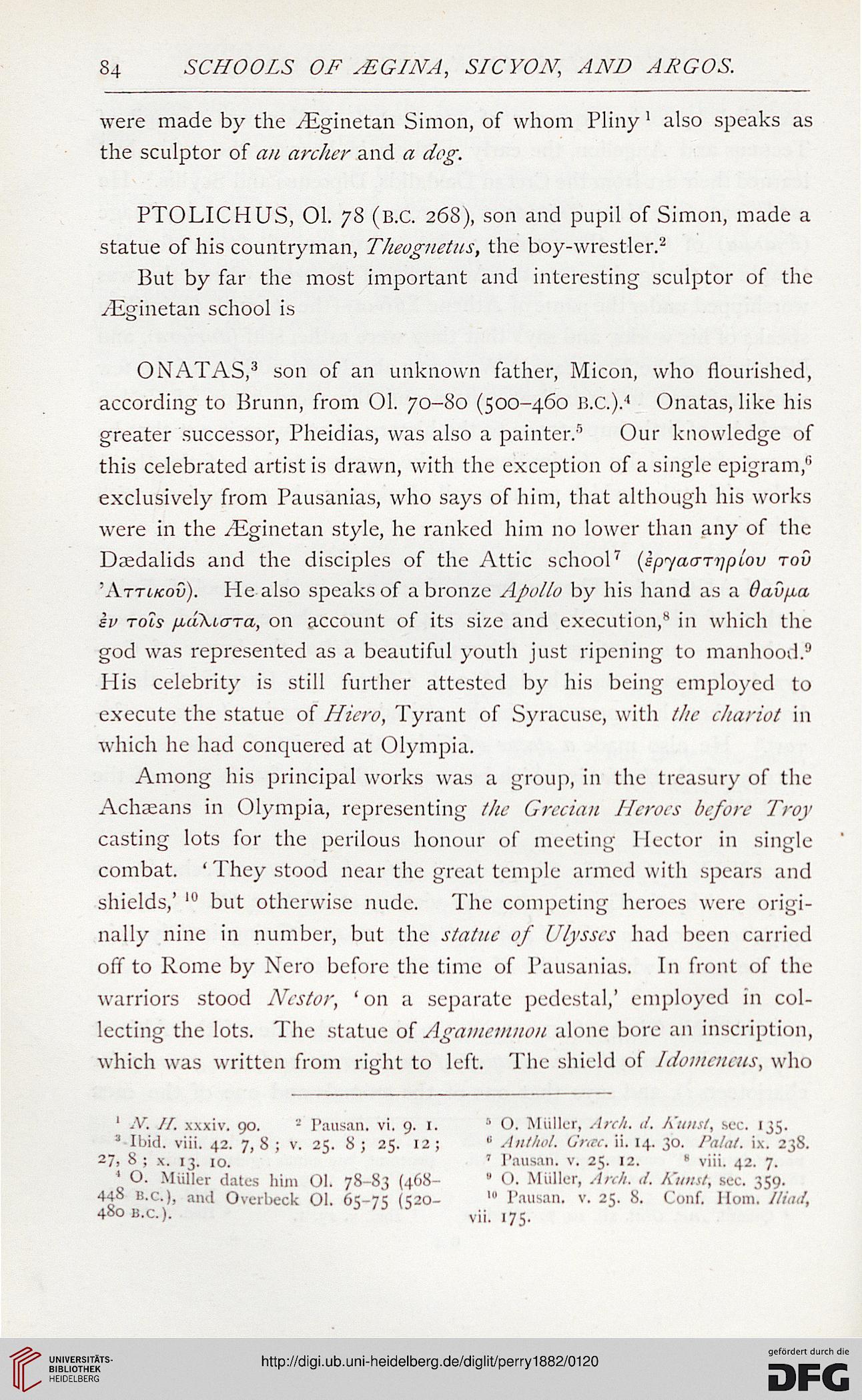S4 SCHOOLS OF sEGINA, SIC YON, AND ARGOS.
were made by the yEginetah Simon, of whom Pliny 1 also speaks as
the sculptor of an archer and a dog.
PTOLICHUS, 01. 78 (B.C. 268), son and pupil of Simon, made a
statue of his countryman, Theognetus, the boy-wrestler.2
But by far the most important and interesting sculptor of the
yEginetan school is
ONATAS,3 son of an unknown father, Micon, who flourished,
according to Brunn, from 01. 70-80 (500-460 B.C.).4 Onatas, like his
greater successor, Pheidias, was also a painter/' Our knowledge of
this celebrated artist is drawn, with the exception of a single epigram,'1
exclusively from Pausanias, who says of him, that although his works
were in the /Eginetan style, he ranked him no lower than any of the
Dredalids and the disciples of the Attic school7 (spyacmiplov tov
'\ttucov). He also speaks of a bronze Apollo by his hand as a Oavfia
sv rols fidXtara, on account of its size and execution,8 in which the
god was represented as a beautiful youth just ripening to manhood.9
His celebrity is still further attested by his being employed to
execute the statue of Hicro, Tyrant of Syracuse, with the chariot in
which he had conquered at Olympia.
Among his principal works was a group, in the treasury of the
Achseans in Olympia, representing the Grecian Heroes before Troy
casting lots for the perilous honour of meeting Hector in single
combat. ' They stood near the great temple armed with spears and
shields,' 10 but otherwise nude. The competing heroes were origi-
nally nine in number, but the statue of Ulysses had been carried
off to Rome by Nero before the time of Pausanias. In front of the
warriors stood Nestor, ' on a separate pedestal,' employed in col-
lecting the lots. The statue of Agamemnon alone bore an inscription,
which was written from right to left. The shield of Idomcncus, who
' AT. //. xxxiv. 90. - Pausan. vi. 9. 1.
' Ibid. viii. 42. 7, 8 ; v. 25. 8 ; 25. 12 ;
27> 8 ; x. 13. 10.
4 O. Miiller dates him 01. 78-83 (468-
448 B.C.), and Overbeck 01. 65-75 (52°-
480 B.C.).
5 O. Miiller, Arch. it. A'UHtt, sec. 135.
0 Ant/iol. Gr<rc. ii. 14. 30. Palat. ix. 238.
' Pausan. v. 25. 12. ■ viii. 42. 7.
• O. Miiller, Arch. J. Kunst, sec. 359.
Pausan. v. 25. 8. Conf. Horn. Iliad,
viii 175-
were made by the yEginetah Simon, of whom Pliny 1 also speaks as
the sculptor of an archer and a dog.
PTOLICHUS, 01. 78 (B.C. 268), son and pupil of Simon, made a
statue of his countryman, Theognetus, the boy-wrestler.2
But by far the most important and interesting sculptor of the
yEginetan school is
ONATAS,3 son of an unknown father, Micon, who flourished,
according to Brunn, from 01. 70-80 (500-460 B.C.).4 Onatas, like his
greater successor, Pheidias, was also a painter/' Our knowledge of
this celebrated artist is drawn, with the exception of a single epigram,'1
exclusively from Pausanias, who says of him, that although his works
were in the /Eginetan style, he ranked him no lower than any of the
Dredalids and the disciples of the Attic school7 (spyacmiplov tov
'\ttucov). He also speaks of a bronze Apollo by his hand as a Oavfia
sv rols fidXtara, on account of its size and execution,8 in which the
god was represented as a beautiful youth just ripening to manhood.9
His celebrity is still further attested by his being employed to
execute the statue of Hicro, Tyrant of Syracuse, with the chariot in
which he had conquered at Olympia.
Among his principal works was a group, in the treasury of the
Achseans in Olympia, representing the Grecian Heroes before Troy
casting lots for the perilous honour of meeting Hector in single
combat. ' They stood near the great temple armed with spears and
shields,' 10 but otherwise nude. The competing heroes were origi-
nally nine in number, but the statue of Ulysses had been carried
off to Rome by Nero before the time of Pausanias. In front of the
warriors stood Nestor, ' on a separate pedestal,' employed in col-
lecting the lots. The statue of Agamemnon alone bore an inscription,
which was written from right to left. The shield of Idomcncus, who
' AT. //. xxxiv. 90. - Pausan. vi. 9. 1.
' Ibid. viii. 42. 7, 8 ; v. 25. 8 ; 25. 12 ;
27> 8 ; x. 13. 10.
4 O. Miiller dates him 01. 78-83 (468-
448 B.C.), and Overbeck 01. 65-75 (52°-
480 B.C.).
5 O. Miiller, Arch. it. A'UHtt, sec. 135.
0 Ant/iol. Gr<rc. ii. 14. 30. Palat. ix. 238.
' Pausan. v. 25. 12. ■ viii. 42. 7.
• O. Miiller, Arch. J. Kunst, sec. 359.
Pausan. v. 25. 8. Conf. Horn. Iliad,
viii 175-




